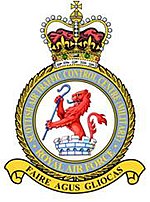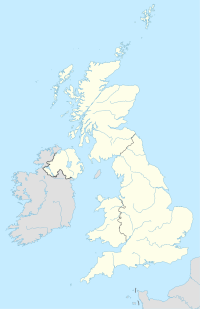Royal Air Force Prestwick or simply known as RAF Prestwick, is a former Royal Air Force station based at the NATS air traffic control centre, adjacent to Glasgow Prestwick Airport, South Ayrshire, in south west Scotland. The unit was home to the Scottish Air Traffic Control Centre (Military) which provided an air traffic control service to military aircraft operating within its area of responsibility. Prestwick was also home to a Distress and Diversion (D&D) Cell which provided assistance to both military and civil aircraft in an emergency.
| RAF Prestwick | |||||||||
|---|---|---|---|---|---|---|---|---|---|
| Prestwick, South Ayrshire in Scotland | |||||||||
 RAF Prestwick on a target dossier of the German Luftwaffe, 1941 | |||||||||
 | |||||||||
| Coordinates | 55°29′48″N 004°35′33″W / 55.49667°N 4.59250°W | ||||||||
| Type | Military air traffic control centre | ||||||||
| Code | PW[2] | ||||||||
| Site information | |||||||||
| Owner | Ministry of Defence | ||||||||
| Operator | Royal Air Force | ||||||||
| Condition | Closed | ||||||||
| Site history | |||||||||
| Built | 1936 | ||||||||
| In use | February 1936 – 2013 | ||||||||
| Fate | Operations transferred to RAF (U) Swanwick. | ||||||||
| Battles/wars | European theatre of World War II Cold War | ||||||||
| Garrison information | |||||||||
| Past commanders | Wing Commander Bruce Duncan (final station commander) | ||||||||
| Airfield information | |||||||||
| Elevation | 11 metres (36 ft)[2] AMSL | ||||||||
| |||||||||
RAF Prestwick was established during the Second World War for the reception of aircraft coming across the Atlantic from North America.
The unit closed in December 2013 with operations transferring to the RAF unit at London Area Control Centre in Swanwick, Hampshire.
History
editPrestwick Airport was established on 17 February 1936 as a base for Scottish Aviation Limited.[3]
Second World War
editDuring the Second World War, Prestwick was used an eastern terminus for the North Atlantic air ferry route, one of a series of routes over which military aircraft were ferried from the United States and Canada to Great Britain, to support the war in Europe. A large number of heavy bombers, fighter aircraft and aircraft carrying diplomatic and VIP passengers transited through the airfield.
RAF Ferry Command was formed on 20 July 1941 to take control of North Atlantic ferry flights but became part RAF Transport Command on 25 March 1943, with the role becoming the responsibility of No. 45 (Atlantic Ferry) Group. Ferry flights were initially controlled by the Overseas Movement Control Centre, operating from a location in Gloucestershire. As the number of flights increased, Trans-Atlantic Air Control (TAC) was relocated in November 1941 to Redbrae House, a mock Tudor home located near Prestwick Airport.[4] A large United States military presence was established at Prestwick to support the ferry flights from North America.[5]
In late 1944, a Flying Control Centre was established in Redbrae House, providing an area control service for the region. The centre was operated by a combination of British, Canadian and American military personnel until the end of the Second World War in 1945.[5]
After the war, responsibility for TAC came under the control of RAF Transport Command after the United States Army Air Forces (USAAF) presence dramatically reduced. The centre at Redbrae House, previously operated by an international alliance of military personnel, was transferred to the Ministry of Civil Aviation and the Oceanic Area Control Centre was created.[5]
Post war
editIn November 1947, the RAF regional control centre was re-designated Scottish Traffic Control Centre (Military) (ScATCC(Mil)) to control military aircraft flying within the airspace above Scotland. Around the same time, a civilian air traffic control service began to meet the demand from the expanding civil aviation market.[5] The unit was staffed by RAF Air Traffic Control Officers and Air Traffic Control Assistants. Both military and civilian aircraft were controlled by RAF controllers who provided a variety of air traffic services predominantly outside controlled airspace or within airspace designated as Military Training Areas. A Distress and Diversion (D&D) cell was co-located with ScATCC (Mil), tasked with assisting aircraft in distress and/or encountering emergency situations.[4]
In April 1977, the D&D cell and the Air Defence Notification Centre (North) (ADNC) moved into new premises at Atlantic House, followed by ScATCC (Mil) on 2 November 1978. ADNC (North) closed on 31 March 1997, with approximately 65 RAF staff remaining at Prestwick.[4]
The Freedom of the South Ayrshire was awarded to RAF Prestwick on 17 July 2009.[6] In November of that year, the unit moved to the new NATS Prestwick Centre, built adjacent to Atlantic House, which accommodates the NATS civilian controllers providing oceanic and Scottish area control services.[5]
The Prestwick Distress & Diversion Cell closed in December 2012 when D&D operations moved to RAF Swanwick in Hampshire.[5]
Role and operations
editPrior to its closure, RAF Prestwick's mission statement was "To contribute effectively to the delivery of airpower by assisting with the protection of the integrity of the UK’s airspace and being at the forefront of excellence in the provision of the air traffic control, airspace management and support services."[7] The main responsibilities of RAF Prestwick was to provide air traffic control (ATC) services to military aircraft carrying out the following activities.[7]
- Flying between 25,000 ft and 66,000 ft
- Crossing the national airways system
- On transit flights operating below 25,000 ft outside controlled airspace
- On operations (such as air-to-air refuelling)
The Distress and Diversion (D&D) Cell was one of two D&D Cells (the other RAF (U) Swanwick) established to provide assistance to both military and civil aircraft experiencing an emergency. The cell maintained a continuous listening watch on both guard frequencies, 121.5 MHz for civilian aircraft and 243.0 MHz for military aircraft and was responsible for co-ordinating responses within UK airspace north of Newcastle and contacting the Aeronautical Rescue Co-ordination Centre (ARCC), which at the time was based at RAF Kinloss in Moray.[8]
The unit at RAF Prestwick was parented by RAF Leuchars in Fife.[9]
Units
editThe following units were based at RAF Prestwick at some point:
- No. 1 Civil Air Navigation School RAF (August 1938 - November 1939)[10] became No. 1 Air Observers Navigation School RAF (November 1939 - July 1941)[11]
- 'D' Flight of No. 1 (Coastal) Operational Training Unit RAF (August - November 1940)[12]
- 'D' Flight of No. 2 (Coastal) Operational Training Unit RAF (November 1940 - July 1941)[12]
- No. 2 Supplementary School of Wireless Telegraphy RAF (September 1939 - October 1940)[13]
- No. 3 Radio School RAF (December 1940 - August 1942)[14] became No. 3 Radio Direction Finding School RAF (August - December 1942)[15]
- No. 4 Ferry Pilots Pool ATA (September 1940 - January 1942) & (August 1942 - October 1945)[16]
- No. 4A Ferry Pilots Pool ATA (January - August 1942)[16]
- No. 4B Ferry Pilots Pool ATA (January - August 1942)[16]
- Detachment of No. 6 Anti-Aircraft Co-operation Unit RAF (March - June 1941)[17]
- Detachment of No. 7 Anti-Aircraft Co-operation Unit RAF (January - May 1941)[17]
- No. 10 Air Observers Navigation School RAF (November - December 1939) disbanded into No. 1 Air Observers Navigation School RAF[11]
- No. 12 Elementary and Reserve Flying Training School RAF (February 1936 - September 1939) became No. 12 Elementary Flying Training School RAF (September 1939 - March 1941)[18]
- No. 1425 (Communication) Flight RAF (October 1941 - April 1942)[19]
- No. 1527 (Beam Approach Training) Flight RAF[18] (October 1941 - September 1945) became No. 1527 (Radio Aids Training) Flight RAF (September 1945 - February 1946)[20]
- No. 1680 (Western Isles Communications) Flight RAF (March - April 1944) became No. 1680 (Transport) Flight RAF (April 1944 - February 1946)[21]
- Squadrons
- No. 102 Squadron RAF[22] (1940)[18]
- No. 114 Squadron RAF[23] (1919)
- No. 141 Squadron RAF[24] (1940)
- No. 253 Squadron RAF[25] (1940)
- No. 263 Squadron RAF[26] (1940)
- No. 600 Squadron RAF[27] (1940-41)
- No. 602 Squadron RAF[27] (1940)
- No. 603 Squadron RAF[27] (1939-40)
- No. 610 Squadron RAF[28] (1940)
- No. 615 Squadron RAF[29] (1940)
Heritage
editThe station badge showed a Lion, (symbolising strength and valour), holding a shepherd's crook, (symbolising watchfulness), within a turret, (symbolising a place of refuge, strength and safety).
The station motto, Faire Agus Gliocas, is Scottish Gaelic for "Watchfulness and Wisdom".[1]
Closure
editThe Minister for the Armed Forces announced on 31 March 2013 that RAF Prestwick would close by the end of 2013. Due to technological advances, there was no longer a requirement for two military area radar control centres in the United Kingdom.The unit subsequently closed on 6 December 2013, when the RAF Ensign was lowered for the final time, representing the end of a 77-year association between Ayrshire and the RAF. Prestwick's operations and thirty personnel were transferred to the RAF unit based in the NATS London Air Traffic Control Centre in Swanwick, Hampshire, forming a single military area radar unit. A small number of RAF personnel remained at Prestwick until January 2014 to complete the transfer.[5][30][31]
See also
editReferences
editCitations
edit- ^ a b "Station Crest". RAF Prestwick. Retrieved 27 November 2017.
- ^ a b Falconer 2012, p. 165.
- ^ "Prestwick Airport". Canmore. Retrieved 26 November 2017.
- ^ a b c "History". RAF Prestwick. Archived from the original on 9 March 2016. Retrieved 26 November 2017.
- ^ a b c d e f g "History of Prestwick Air Traffic Control Centre". NATS Blog. NATS. Retrieved 26 November 2017.
- ^ Dailyrecord.co.uk (16 July 2009). "Freedom of South Ayrshire for armed forces". Dailyrecord.co.uk. Retrieved 28 February 2019.
- ^ a b "Military Operations". RAF Prestwick. Retrieved 27 November 2017.
- ^ "Distress & Diversion Cell". RAF Prestwick. Retrieved 27 November 2017.
- ^ "Station facilities". RAF Prestwick. Retrieved 27 November 2017.
- ^ Sturtivant, Hamlin & Halley 1997, p. 90.
- ^ a b Sturtivant, Hamlin & Halley 1997, p. 59.
- ^ a b Sturtivant, Hamlin & Halley 1997, p. 233.
- ^ Sturtivant, Hamlin & Halley 1997, p. 285.
- ^ Sturtivant, Hamlin & Halley 1997, p. 254.
- ^ Sturtivant, Hamlin & Halley 1997, p. 253.
- ^ a b c Sturtivant, Hamlin & Halley 1997, p. 115.
- ^ a b Sturtivant, Hamlin & Halley 1997, p. 71.
- ^ a b c "Prestwick". Airfields of Britain Conservation Trust. Retrieved 5 February 2016.
- ^ Sturtivant, Hamlin & Halley 1997, p. 131.
- ^ Sturtivant, Hamlin & Halley 1997, p. 139.
- ^ Sturtivant, Hamlin & Halley 1997, p. 144.
- ^ Jefford 1988, p. 54.
- ^ Jefford 1988, p. 57.
- ^ Jefford 1988, p. 61.
- ^ Jefford 1988, p. 78.
- ^ Jefford 1988.
- ^ a b c Jefford 1988, p. 98.
- ^ Jefford 1988, p. 99.
- ^ Jefford 1988, p. 100.
- ^ Ducan, Wing Commander Bruce (9 December 2013). "RAF Prestwick Ensign Lowering Ceremony". Royal Air Force. Retrieved 26 November 2017.
- ^ Buchanan, Jen (29 March 2013). "RAF to pull out of Ayrshire". Daily Record. Retrieved 11 August 2017.
Bibliography
edit- Falconer, J (2012). RAF Airfields of World War 2. UK: Ian Allan Publishing. ISBN 978-1-85780-349-5.
- Jefford, C G (1988). RAF Squadrons. A comprehensive record of the movement and equipment of all RAF squadrons and their antecedents since 1912. Shrewsbury: Airlife. ISBN 1-85310-053-6.
- Sturtivant, R; Hamlin, J; Halley, J (1997). Royal Air Force flying training and support units. UK: Air-Britain (Historians). ISBN 0-85130-252-1.

